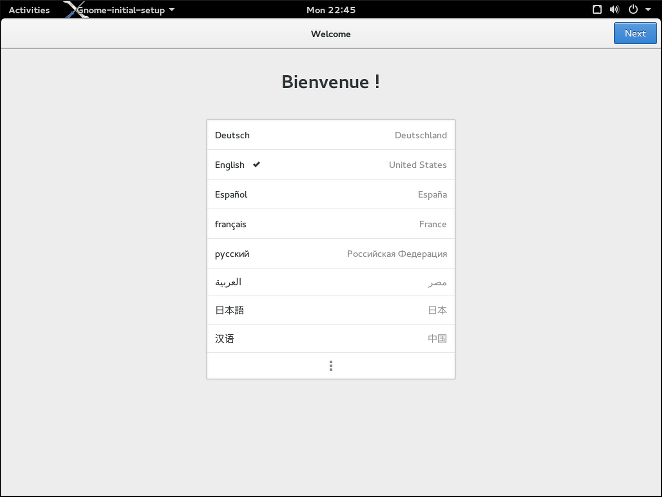安装后
本章描述了在第一次安装操作系统、重启并登录后打开的初始设置工具。
两个分开的配置是Fedora的一部分。如果你安装了[application]*GNOME*桌面环境(Fedora工作站版本的、默认的Fedora环境),那么[application]*GNOME Initial Setup*工具将开启。对于其他桌面环境而言,[application]*Initial Setup*也会开启。
这两个工具允许你配置用户指定的、安装过程中没完成的设置。一些设置项既在图形安装器中可用,也在Kickstart命令中可用。如果使用Kickstart方式,则只会在第一次重启后显示跳过的那些设置。这意味着如果你在安装完成前配置了用户账号,那么在安装完成后将不会提示配置用户账号。
初始设置
“初始设置”屏幕会在系统安装完成后的第一次启动时显示。在首次登录之前,假设我们可能遇到以下情况:
-
你的软件集包含了一个图形环境(举个例子,你安装了一个使用Fedora Workstation live镜像的操作系统)。
-
你安装的图形环境*不是*GNOME Desktop Environment (它提供的是它自身的初始设置工具,在GNOME Initial Setup被描述) 。
-
软件包[package]*initial-setup*已经被安装好了。
-
你还没配置完图形安装器里面的每个屏幕。

[application]*Initial Setup*允许你配置一个或多个系统设置。所有的设置也可以在安装操作系统时进行配置,但不要求一次配完。只有那些在安装操作系统的过程中*没有*配置过的选项才会在这里显示出来。举个例子:如果你在安装操作系统时没创建一个非root用户,那么[application]*Initial Setup*就会在安装完成重启后启动,然后你就可以创建一个非root用户了。如果你已经在安装操作系统时配置了所有的选项,那么[application]*Initial Setup*根本不会显示。
To configure any aspect of the system available in the utility, click any of the links available in the main window (for example, Create User). Each link leads to a separate screen with separate options; these screens are the same ones which were available during the graphical installation. If you need help, press Help in the top left corner to open a new window containing directions for that screen.
After you finish configuring any screen, press the Done button in the top left corner to return to the main Initial Setup menu. After you finish configuring all settings, click Finish Configuration in the bottom right corner to save all configured settings. The configuration utility will close and you will be able to log in to the system.
|
It is possible to configure Initial Setup to display all available options, even if they have been already configured during the installation. To do so, you must use a Kickstart file at the start of the installation, and this file must contain the following command: firstboot --enable --reconfig The --reconfig option specifies that all options should be displayed. See Automating the Installation with Kickstart for information about Kickstart installations. |
|
Normally, it is not possible to return to Initial Setup after you close it and log in to the system. You can make it display again (after the next reboot, before a login prompt is displayed), by executing the following command as # systemctl enable initial-setup-graphical.service Then, reboot your system. |
GNOME初始设置
只要你使用[application]*GNOME*桌面环境首次登录,那么无论用哪一个账号进行登录,[application]*GNOME Initial Setup*工具都将在首次登录后显示。

本工具允许你配置用户指定的设置,例如系统语言和默认键盘布局。可以使用在窗口上方的`Next`和`Previous`按钮来在屏幕上导航。有些屏幕(例如`配置在线账号`)是可选的,可以点击在窗口右上角的`Skip`按钮来跳过。
在完成了所有屏幕的配置之后,点击`Start using Fedora`按钮来退出工具。此后将会显示在GNOME帮助中的`Getting Started`页面,然后你要么可以继续浏览帮助页面,要么可以关闭此页面并开始使用你的桌面。
常用安装后任务
在你完成安装、走完一遍初始设置流程后,你的操作系统就已经可以用了。然而,其他管理员相关的、又必要的任务可能不包含在初始设置当中,这取决于你如何使用操作系统。下面列出了一些在安装后通常立即执行的、常见的任务。
- 恢复丢失的`root`密码
-
The
rootpassword, which is configured during the installation, is required for accessing the system as therootuser. Without this password you will not be able to configure your system or install additional software. If you lost or forgot yourrootpassword, you can reset it by following the steps described in Resetting the Root Password. - 配置网络
-
In most cases, network access is configured during the installation process, either in the Anaconda installation program (see Network & Hostname) or in a Kickstart file (see network (optional) - Configure Network Interfaces). For information on configuring the network after the installation, see the Fedora Networking Guide, available at https://docs.fedoraproject.org/.
- 进行第一次系统升级
-
如果你用full ISO镜像安装了Fedora(例如Workstation live image或者full Server DVD),那么推荐你进行第一次系统升级,因为你的安装媒体应该是包含了老旧版本的软件包。在第一次系统升级当中,所有的安装过的软件包都会被升级到最新版本。软件包升级提供了安全修复、bug修复和功能提升。
The DNF package manager is used for updating installed packages. For more information about updating your system with DNF, see the Fedora System Administrator’s Guide.
- 安装驱动更新
-
Usually, drivers for system devices are already supported in the kernel provided by Fedora. However, occasionally, support for devices that have been released recently could be missing. In these cases, a driver update enabling your device may be available.
Devices necessary to complete the installation can have driver updates provided before the installation begins. If a device is missing a driver, but it is not essential during the installation, it is recommended to wait until after the installation completes, and install additional drivers afterwards. For instructions on installing and enabling additional drivers on the installed system using RPM and DNF, see the Fedora System Administrator’s Guide.
- 配置额外软件源
-
安装在_软件源_的新软件。软件源由软件集和元包组成,并且可以被[application]*DNF*包管理器获取到。默认地,Fedora提供的一些update源已经被自动配置好了,并且你可以用这些update源安装更新和额外软件。然而,如果你想要设置例如包含你自己的软件包的额外软件源,则需要一些额外步骤。
For information about configuring additional software repositories, see the Fedora System Administrator’s Guide, available at https://docs.fedoraproject.org/.
- 安装额外软件包
-
You can control which packages will be installed by selecting an environment in the
Software Selectiondialog in the graphical installation (see Software Selection). This dialog does not provide a way to choose individual packages, only predefined sets. However, you can use the DNF package manager to install additional packages after the installation. See the Fedora System Administrator’s Guide. - 切换至图形登录
-
取决于你在安装过程中的选项,你的操作系统可能没有图形界面,此时系统只提供文本的提示。在这种情况下如果你想在安装后启用图形桌面,那么你必须安装[application]X Window系统*和你偏好的桌面环境(可以是[application]*GNOME*或[application]*KDE)。
As with all other software, these packages can be installed using the DNF package manager. For information about using DNF to install new packages, see the Fedora System Administrator’s Guide. For information on how to enable graphical login by default, see Booting into a Graphical Environment.
Want to help? Learn how to contribute to Fedora Docs ›